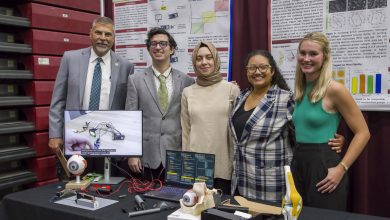Florida Tech Discovery Magazine, Spring 2019: Reducing Runway Incursions
This article is featured in the Spring 2019 edition of Discovery, Florida Tech’s research magazine. To view this edition and Florida Tech’s archive, click here.
If you’ve flown even occasionally, you likely experienced the downside of a runway incursion. You find yourself sitting in your plane, parked at the gate or taxiway, as the situation plays out beyond those tiny oval windows.
A runway incursion is when a plane, vehicle or even pedestrian is on the runway without permission. The danger is that there is a second aircraft landing or taking off at the same time. The Federal Aviation Administration (FAA) has five categories for incursion severity, ranging from no other aircraft on a runway to an actual collision, but most any of them will, at least temporarily, keep a plane from taking off.
Researchers at Florida Tech conducted research to better understand runway incursions and to help develop ways to curtail them and improve the flying experience for many travelers.
Through the FAA’s Center of Excellence for General Aviation, known as the Partnership to Enhance General Aviation Safety, Accessibility and Sustainability (PEGASAS), Florida Tech was selected to participate in three studies on runway incursions and how to decrease their frequency.
The first study, led by Florida Tech College of Aeronautics professor Donna Wilt, working with a team from Florida Tech, Purdue University School of Aeronautics and Astronautics, and Hampton University, analyzed the root causes of general aviation runway incursions. Data show most runway incursions are attributed to inadvertent actions by pilots during general aviation operations, and researchers used qualitative interviews and a nationwide questionnaire to hear directly from pilots on what they believe are the causes and solutions to runway incursions. They also analyzed aviation safety databases from the National Transportation Safety Board, and NASA Aviation Safety Reporting System to identify trends specific to general aviation operations.
The interviews and questionnaires gathered over 1,400 suggestions from pilots that were then organized and compiled by the team. Specific recommendations for improvements included changes to communication procedures between pilots and the control tower, better methods to disseminate airport information, improvements to pilot training, and improvements to signs and pavement markings on the airport.
Another study was led by Florida Tech College of Aeronautics professor and graduate program Chair Debbie Carstens, who worked with a team from Florida Tech, The Ohio State Center for Aviation Studies and Iowa State University’s Program for Sustainable Pavement Engineering. The objective of the research was to analyze accidents and incidents that occurred at or near airports and to identify actual or potential airport safety risks related to those accidents and incidents. The secondary goal was to provide input on the development of metrics for future analysis reports to identify the top risks for airport safety.
The benefit of the research is increased insight into eliminating or mitigating the risk factors that result in incidents and accidents by thorough aggregation of all available airport-safety-related data into one database developed by CSRA Inc. (now General Dynamics Information Technology). The data was categorized using the Commercial Aviation Safety Team and the International Civil Aviation Organization (CICTT) taxonomy for occurrence categories and phases of flight. The database, which is not available to the public, can also allow users to see the top 10 airports with the most runway incursions.
“The research helps to identify where future airport safety initiatives should focus by having data be more meaningful by categorizing it into the database,” Carstens said. “What we did as part of that research effort is make sure from these data sources we were able to fill in the CICTT taxonomy so the FAA can compare apples to apples.”
The third study was led by Florida Tech College of Aeronautics professor and Human Factors Program Director of Research and Chair John Deaton, who worked with a team from Florida Tech investigating the human factors involved in runway safety. That led to a focus on improving airfield features such as airport signage, markings and lighting.
Steve Cusick, PEGASAS site director at Florida Tech, said the three areas studied offer critical data and insight on an important aviation issue.
“When you bring these three research projects all together you have a bigger picture of the runway safety situation on this high-priority FAA program,” he said.
###






